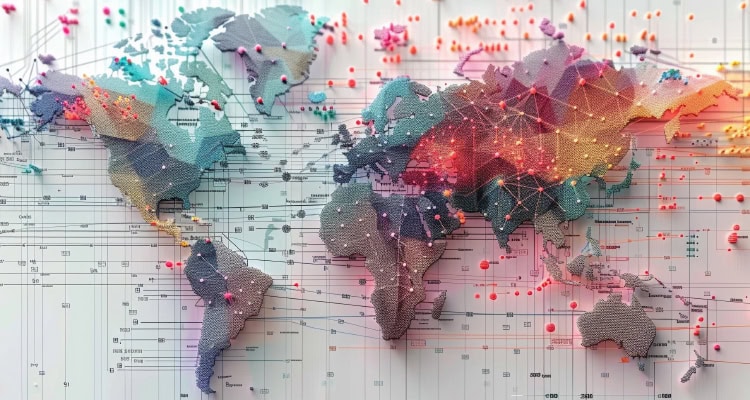Beyond the Buzz: Tariffs

Industry experts weigh in on the long-term impact of tariffs, exploring how digital logistics, regionalized trade, and the shift toward nearshoring and friendshoring are reshaping global supply chains.
Long-Term OutLook
Unpredictable tariffs are part of a larger trend of disruption. This trend is nudging smart supply chain companies to develop technology that can give their customers deeper flexibility and visibility, offering it as a bulwark against instability. In 10 years, digital-first logistics providers will be the norm.
–Timothy O’Connell
Senior Director, Sales Operations
Odyssey Logistics
Trump-era tariffs are prompting companies to diversify sourcing, reducing reliance on a single country. Over the next 10 years, global trade will become more regionalized and digitized, with supply chains shaped by political alliances, tech-driven logistics, and a push toward national and economic resilience.
–George Maksimenko
CEO
Adexin
Tariffs aren’t causing supply chain transformations—they’re accelerating changes already underway. In 10 years, we’ll see shorter, more regional supply chains optimized for resilience. Companies will prioritize supplier diversity over lowest price. Global trade won’t decrease—it will fragment into regional ecosystems with higher technology integration. The winners will be companies building supply chains around flexibility rather than pure efficiency.
–Matt Lhoumeau
CEO
Concord
Nearshoring Over Reshoring
Nearshoring, or friendshoring, appears much more likely to benefit from tariffs this time around than reshoring, and Mexico is considered to be a net beneficiary, according to BofA Global Research.
Only 20% of respondents expect significant reshoring, while 40% call for mild relocation to the United States within select sectors including electronics, biotechnology, and metals and mining. These sectors are more capital- than labor-intensive, and are expected to take one to three years to complete any reshoring initiatives.
Source: BofA Global Research. Based on a proprietary survey of 56 analysts, based in 9 countries, covering 1,029 companies that represent more than $38 trillion of market cap.
Net Positives
We will continue the shift to domestic production, and more trade balance than we have now. Hopefully our product quality will improve, and our on-time delivery track record for experts will improve as we compete globally on more than price, due to tariffs.
–Danny Schnautz
President
Clark Freight Lines Inc.
There will be a dramatic increase in domestic manufacturing, especially of critical products related to national security. There will be a transition to regional supply chains (nearshoring) with an increase in suppliers in Latin America as well as a transition to friendshoring around the globe. Although there will be large variances depending on the supplier, we expect it to be mildly inflationary overall and negligible in the long-term.
–Lisa Anderson
President
LMA Consulting Group, Inc.
Tariffs are pushing companies to rethink global networks and supply chain bases, shifting toward nearshoring, friendshoring, and regional hubs. Reliance on single sources or tariffs-prone markets like China will decline, while investments in tech that boosts agility and insight will become critical to mitigate risks, maximize revenue, and optimize costs. Global trade will need to balance stakeholder demands for compliance, security, and safety, inevitably adding complexity.
–Kristian O’Meara
SVP of Strategic Initiatives
JAGGAER
Expect Turbulence
If unpredictability continues, long-term implications include weakened U.S. trade influence and a global pivot toward alternative markets. In a decade, resilient supply chains won’t chase the lowest cost, they’ll hedge against political uncertainty and diversify to survive the next disruption.
–Ken Feinstein
Vice President
MIDCOM Data Technologies
By 2035, expect stronger regional blocs and reduced China dependence, but fragmented markets may increase costs despite tech-driven efficiency gains.
–Lucas Manganaro
Managing Director, Business Performance Improvement
Protiviti
Trump’s tariffs will raise trade costs and create friction but won’t reverse globalization. Supply chains will adapt through diversification, nearshoring, and inventory buffers. In 10 years, expect higher-cost but more resilient networks—firms will pay premiums for flexibility. Trade flows will shift geographically, but global integration is likely to remain economically inevitable.
–Michelle Green
Chief Economist
Board
This administration’s tariffs, combined with overwhelming regulatory reality and existing sanctions, create a Bermuda triangle that should concern every CEO. Long term, this may threaten geopolitical stability and tech supply chains, potentially leading to a devaluation of currency. In the short term, expect supplier pain and a far less overstocked holiday season.
–Ted Krantz
CEO
interos.ai
The tariffs were aimed at boosting domestic manufacturing, but instead created uncertainty, and forced companies to rethink their sourcing strategies. Reshoring to the United States has occurred in select sectors, but many have shifted to countries like India to reduce tariff exposure.
–Bryan Gerber
Co-Founder & CEO
Hara Supply
Winning Moves
Organizations need to embrace technology that can help understand the impact of these dynamic changes in real time, making data-driven adjustments possible along the way.
–Josh Dunham
CEO and Co-Founder
Reveel
The tariffs are pushing businesses to forge new supplier relationships, optimize inventory management, and embrace digital tools that support proactivity (like ERP and MES). Resiliency is the name of the game—the more businesses can plan ahead, build and activate contingency plans, and use data to fortify their operations, the better they’ll fare during periods of disruption.
–Ryan McMartin
Product Marketing Manager
Parsec Automation
Global trade will become more adaptive, with more regionalized, AI-enabled sourcing strategies and strong partnerships with third-party data providers to boost visibility, optimize costs, manage risk, and ensure compliance.
–Brian Filanowski
General Manager, Finance & Risk and Capital Markets
Dun & Bradstreet
About $100 billion in lost productivity across U.S. businesses can be attributed to tariff whipsaw and the uncertain environment that’s here to stay. However, the winning playbook stays the same: agility, resilience, responsiveness.
–Aman Khan
Partner in the Strategy and Organization Transformation practice
Kearney
Turning Tariff Volatility into Logistics Advantage
By DeAnna Harner
Executive Supply Chain & Operations Advisory Lead America’s Manufacturing, CPG, and Retail EOU Avanade
 Unpredictable swings in trade policy and tariffs now drive disruption. Each new development forces global companies to adjust sourcing, recalculate landed costs, and rethink pricing, often with little lead time.
Unpredictable swings in trade policy and tariffs now drive disruption. Each new development forces global companies to adjust sourcing, recalculate landed costs, and rethink pricing, often with little lead time.
While tariffs have been around for hundreds of years (in the 1700s, they were the primary way the young U.S. government raised revenue), what’s different now is the pace of change and the operational strain it causes behind the scenes.
Every shift in tariff rates means logistics and procurement teams must:
- Update pricing databases with per-item accuracy
- Factor in multi-country, multi-currency impacts
- Analyze cost-to-serve by SKU and supplier location
- Reassess sourcing lanes and fulfillment routes
And all of this must happen before even beginning to make decisions like:
- Do we absorb some or all of the new cost?
- Should we shift suppliers to mitigate exposure?
- Can we adjust stocking strategies in advance?
- What’s the ROI on reshoring production?
For organizations still relying on manual processes, this complexity compounds and creates real margin risk.
Gaining Real-Time Visibility
The ability to simulate the impact of tariff shifts in real time and coordinate across sourcing, finance, and logistics teams is now a strategic advantage. Look for solutions that offer: automated tariff data ingestion and SKU-level mapping; AI-driven simulations of landed cost changes; real-time alerts and what-if modeling; and integration with ERP and WMS platforms. Some solutions are built on low-code platforms enabling rapid deployment without disrupting current systems.
In one example, an international retailer with $3.5 billion in annual revenue implemented a tariff management protocol using such a system. The result? An expected $36.5 million in recaptured margin annually, thanks to automated tariff-to-SKU mapping and faster reaction times.
Beyond financial gains, the company gained agility—the ability to simulate scenarios instantly, act on trade shifts quickly, and align teams around a single source of truth.
Key Questions for Today’s Decision-Makers
If you lead logistics, sourcing, or supply chain strategy, consider:
- How confident are you in your organization’s ability to adapt quickly to trade shifts?
- Are your current tools fast and accurate enough to support “what-if” planning?
- How much margin is being lost due to manual processes or delayed updates?
- Can your systems align procurement and logistics strategies in real time?
In an industry where resilience and responsiveness are the new currency, tariff management isn’t a tax issue. It’s a supply chain mandate.
Apparel brands are battling tariffs:
- GAP INC. warned that tariffs could pile on up to $300 million in incremental costs in 2025 alone. It’s aiming to reduce China sourcing from under 10% in 2024 to under 3% by year-end and limit any single country to 25% by 2026.
- ABERCROMBIE & FITCH expects a $50 million tariff hit this year despite sourcing across 16 countries.
- AMERICAN EAGLE OUTFITTERS anticipates $40 million in added costs and is pushing to get China exposure below 10% by the holidays.
Rob Garrison, senior director of enterprise, TradeBeyond, details how apparel brands are redesigning supply chains for tariff resilience here: www.inboundlogistics.com/articles/fashion-in-flux/
Tariffs have turned supply chains into a geopolitical chessboard—every move carries strategic risk. To stay ahead, companies should stress test sourcing models for tariff exposure, risk, and supplier concentration just like a financial portfolio.
–Adam Beckerman
Manufacturing and Distribution Leader
Aprio
7 Supply Chain Tactics and Their Trade-offs
By J.C. Renshaw
Head of Supply Chain Consulting for North America, Savills
 While long-term resilience remains a critical objective, companies are leaning on a set of short-term tactics to navigate on-again, off-again tariff policies and disruptions:
While long-term resilience remains a critical objective, companies are leaning on a set of short-term tactics to navigate on-again, off-again tariff policies and disruptions:
Front-loading
Stockpiling—especially containerized imports—or pulling freight forward.
THE UPSIDE: Can shore up supply and reduce the risk of inventory shortages. Companies can also bring in goods before higher tariff rates take effect.
THE TRADE-OFFS: Works only if a company has—or can secure—excess storage capacity. Risks: overstocking and holding too much inventory for too long, including goods that may become obsolete. Shipping rates can spike when many companies front-load at once.
Bonded warehouses and FTZs
Turning to bonded warehouses and Foreign-Trade Zones (FTZs) to hedge against both potential tariff increases and decreases.
THE UPSIDE: If tariffs are expected to decline in the near future, bonded warehouses can be a smart strategy for importers of finished goods. For manufacturers, FTZs offer greater flexibility. Companies operating in FTZs can avoid tariffs on raw materials and choose to apply either the tariff rate in effect at the time of entry or at the time of withdrawal.
THE TRADE-OFFS: Both come with costs—not just fees, but also the time and effort required to comply with government oversight. Capacity is limited as well, making access competitive.
Leveraging third-party logistics providers (3PLs)
3PLs offer warehousing, transportation, and fulfillment services that can scale quickly.
THE UPSIDE: Allows companies to stay nimble—avoiding major capital commitments while meeting demand. Quick way to add capacity and tap into logistics expertise without signing a long-term warehouse lease.
THE TRADE-OFFS: Short-term or overflow 3PL arrangements can be more expensive than traditional warehousing, and costs can rise quickly in tight markets.
Shifting sourcing and production
Shifting production closer to end markets—through investments in domestic manufacturing or nearshoring to places like Mexico.
THE UPSIDE: Reduces dependency on Asia and shortens lead times. Diversifying suppliers improves flexibility, enhances disaster recovery options, and strengthens negotiating power. These strategies can lower inventory costs, boost supply chain performance and, in many cases, qualify for government incentives.
THE TRADE-OFFS: Decentralizing production can erode economies of scale, raise costs, and introduce quality control challenges that may harm brand integrity. Managing multiple sites often requires added headcount, slows operations during audits or corrections, and increases exposure to inconsistent regulations.
Rerouting to lower-duty ports
Routing goods through a third country—a tactic known as transshipment.
THE UPSIDE: Offers a way to avoid tariffs without changing suppliers or building new facilities. Companies can continue producing in lower-cost countries like China while routing goods through places like Vietnam or Mexico to reduce duties. Can control costs and preserve supply relationships.
THE TRADE-OFFS: Increasingly risky since many passthrough nations are now under heightened scrutiny, and U.S. Customs is ramping up audits, inspections, and stricter enforcement of origin rules. Violations can trigger penalties under the False Claims Act or Section 301 and 232 tariffs. Companies face significant legal and financial exposure and should consult trade experts to develop compliant strategies.
Reclassifying and redesigning products
Modifying a product just enough to shift it into a lower-duty classification, also known as tariff engineering.
THE UPSIDE: Reduced import duties, which can significantly lower costs over time. Effective when design tweaks can be made without compromising product performance, branding, or customer experience.
THE TRADE-OFFS: Design changes may compromise product quality or performance, potentially damaging brand reputation. They may also add manufacturing complexity and cost. Additionally, tariff classifications and rates can shift, and missteps in documentation or compliance can carry legal and financial consequences.
Automation and technology
Increasing investments in automation and efficiency-enhancing technologies.
THE UPSIDE: Automation and densification technologies ease pressure on space-constrained facilities.
THE TRADE-OFFS: Automation can require moderate to significant upfront investment. Companies must vet technologies for cost justification, reliability, and long-term value.
